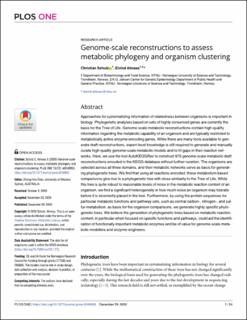| dc.contributor.author | Schulz, Christian | |
| dc.contributor.author | Almaas, Eivind | |
| dc.date.accessioned | 2022-05-13T13:07:55Z | |
| dc.date.available | 2022-05-13T13:07:55Z | |
| dc.date.created | 2021-01-04T15:47:09Z | |
| dc.date.issued | 2020 | |
| dc.identifier.citation | PLOS ONE. 2020, . | en_US |
| dc.identifier.issn | 1932-6203 | |
| dc.identifier.uri | https://hdl.handle.net/11250/2995671 | |
| dc.description.abstract | Approaches for systematizing information of relatedness between organisms is important in biology. Phylogenetic analyses based on sets of highly conserved genes are currently the basis for the Tree of Life. Genome-scale metabolic reconstructions contain high-quality information regarding the metabolic capability of an organism and are typically restricted to metabolically active enzyme-encoding genes. While there are many tools available to generate draft reconstructions, expert-level knowledge is still required to generate and manually curate high-quality genome-scale metabolic models and to fill gaps in their reaction networks. Here, we use the tool AutoKEGGRec to construct 975 genome-scale metabolic draft reconstructions encoded in the KEGG database without further curation. The organisms are selected across all three domains, and their metabolic networks serve as basis for generating phylogenetic trees. We find that using all reactions encoded, these metabolism-based comparisons give rise to a phylogenetic tree with close similarity to the Tree of Life. While this tree is quite robust to reasonable levels of noise in the metabolic reaction content of an organism, we find a significant heterogeneity in how much noise an organism may tolerate before it is incorrectly placed in the tree. Furthermore, by using the protein sequences for particular metabolic functions and pathway sets, such as central carbon-, nitrogen-, and sulfur-metabolism, as basis for the organism comparisons, we generate highly specific phylogenetic trees. We believe the generation of phylogenetic trees based on metabolic reaction content, in particular when focused on specific functions and pathways, could aid the identification of functionally important metabolic enzymes and be of value for genome-scale metabolic modellers and enzyme-engineers. | en_US |
| dc.description.abstract | Genome-scale reconstructions to assess metabolic phylogeny and organism clustering | en_US |
| dc.language.iso | eng | en_US |
| dc.publisher | Public Library of Science | en_US |
| dc.rights | Navngivelse 4.0 Internasjonal | * |
| dc.rights.uri | http://creativecommons.org/licenses/by/4.0/deed.no | * |
| dc.title | Genome-scale reconstructions to assess metabolic phylogeny and organism clustering | en_US |
| dc.title.alternative | Genome-scale reconstructions to assess metabolic phylogeny and organism clustering | en_US |
| dc.type | Peer reviewed | en_US |
| dc.type | Journal article | en_US |
| dc.description.version | publishedVersion | en_US |
| dc.source.pagenumber | 24 | en_US |
| dc.source.journal | PLOS ONE | en_US |
| dc.identifier.doi | 10.1371/journal.pone.0240953 | |
| dc.identifier.cristin | 1865058 | |
| dc.relation.project | Norges forskningsråd: 294605 | en_US |
| dc.relation.project | Norges forskningsråd: 271585 | en_US |
| cristin.ispublished | true | |
| cristin.fulltext | original | |
| cristin.qualitycode | 1 | |

